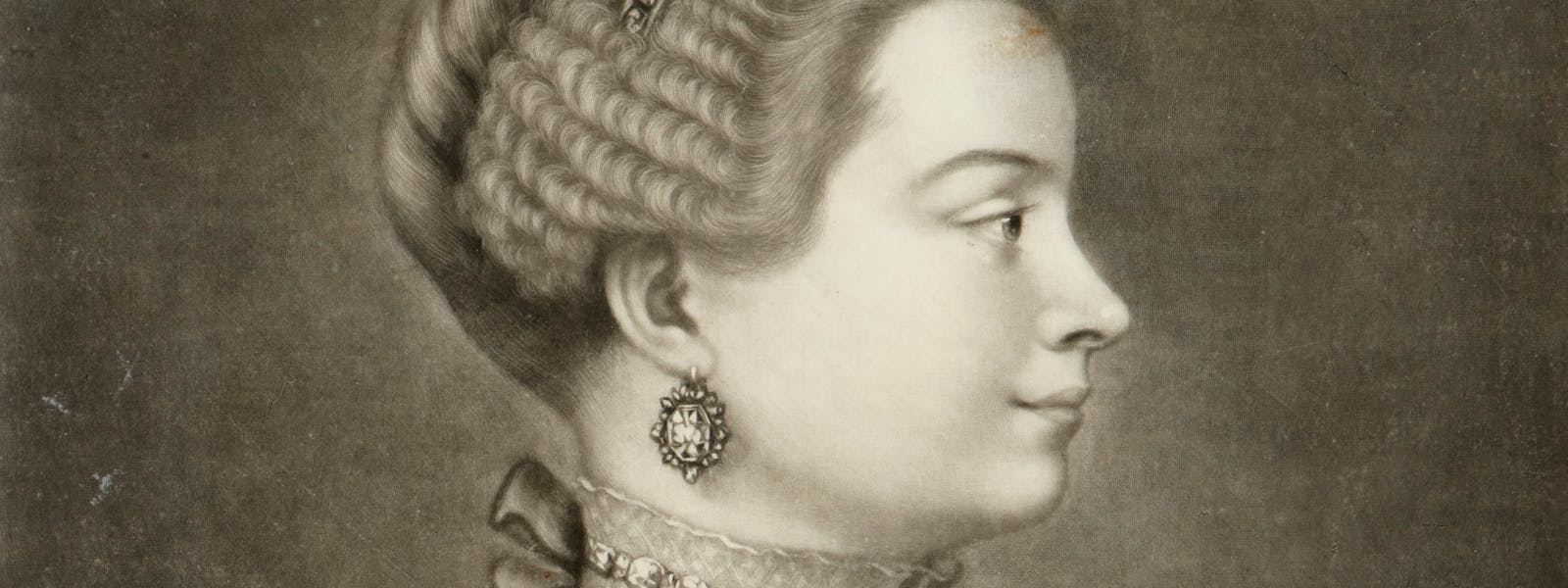
'Sensible, cheerful and remarkably genteel'
Queen Charlotte was wife to King George III. They shared a happy life together, producing 15 children until their lives were changed and saddened by the King’s devastating mental illness. Nonetheless, Charlotte remained steadfast and loyal to her husband.
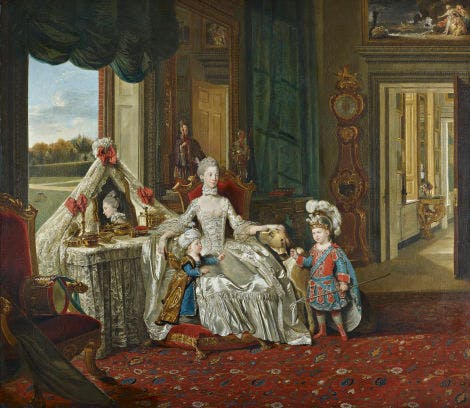
Image: Queen Charlotte (1744-1818) with her two eldest sons c1765, Royal Collection Trust / © Her Majesty Queen Elizabeth II 2017
Born to be queen
Princess Sophie Charlotte was born in 1744 in the Palace of Mirow in a little known principality of Mecklenberg-Strelitz, in what is now part of Germany. It was an idyllic location in which to grow up. The castle, on a lake and surrounded by woods, resembled something out of Beauty and the Beast.
She was ‘well enough’ educated and spoke French, and she excelled in music. Crucially for her marriage prospects, she was sweet and good-humoured, with a ‘lively but equable temper’.
In 1761, aged 17, Charlotte found herself chosen by George III as his bride. She had good royal and Protestant credentials. Most importantly for the King, she was sweet natured and compliant.
Charlotte also had ‘a most agreeable countenance’ without being ravishingly beautiful. Lord Harcourt, sent by George III to collect her from her childhood home, describes her ‘very pretty eyes’ but comments she is no ‘regular beauty’. However, she had her charms, including ‘white and even teeth’.
Everyone in London was eager for a glimpse of the Princess when she met her husband-to-be. One onlooker said she was ‘tall, with a fine air and brown hair’.
Did you know?
When she arrived in England, Charlotte was so thin after a bout of sea sickness that her heavy, diamond encrusted wedding dress nearly fell off her.

Image: Engraving 'Charlotte Queen of Great Britain' 1761. © Historic Royal Palaces
This portrait shows Charlotte just two months after her marriage: it shows the Queen in right profile, with her hair up, a tiara, jewelled necklace and earrings, a low gown, brocade bodice with jewels, and with ermine mantle.
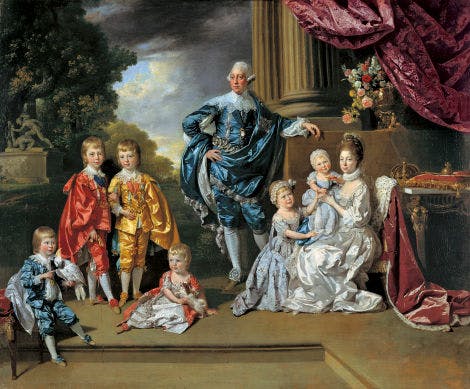
Image: George III (1738-1820), Queen Charlotte (1744-1818) and their six eldest children, Royal Collection Trust/© Her Majesty Queen Elizabeth II 2017
Devoted wife and mother
The first 25 years of the King and Queen’s marriage were happy ones. They would attend plays and concerts together and duet on the harpsichord and flute. When not at court, their lives were rural and informal in their homes at Windsor and in Kew.
Together they had 15 children and the Queen was responsible for their early education, employing and supervising their governesses and tutors. In 1789, when the King became ill, his inappropriate behaviours terrified and upset the Queen. Their relationship was never the same and they led increasingly separate lives.
Happiness cut short
The King's first bout of ill health in 1788 began with physical symptoms, before recurring bouts of severe mental illness.
It was decided to move him to Kew Palace, so Charlotte and some of their daughters went on ahead to entice him. However, the King was kept isolated, seen only by his doctors, which both the King and Queen found hugely distressing.
Charlotte became very frustrated by the seemingly incompetent royal doctors. It’s likely that the King recovered in a few months despite, rather than because of his treatment (which included leeching and cold baths). However, his subsequent bouts in 1801 and 1804 made him violent, so Charlotte had to avoid him for her own safety.
Did you know?
By 1789, Charlotte’s hair had turned white under the stress of the King’s illness.
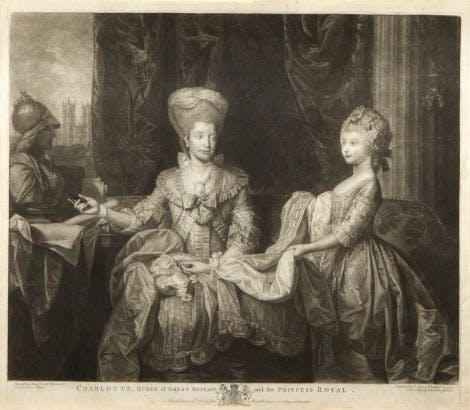
Image: Queen Charlotte with Charlotte, Princess Royal. © Historic Royal Palaces
Sure never was anyone to be more pitied than her Majesty, as no couple had ever been happier than they were before this greatest of all misfortunes.
Mrs Philip Lybbe Poyse, 1788, who had watched George and Charlotte's coronation procession 27 years earlier
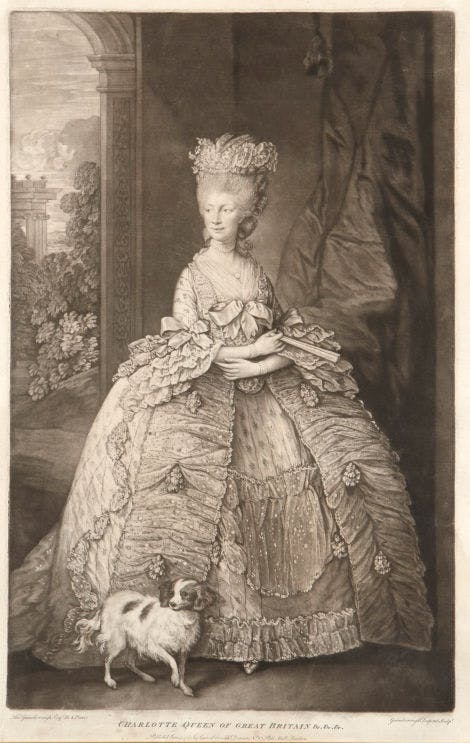
Image: Queen Charlotte, accompanied by her papillon spaniel, after Thomas Gainsborough. @ Historic Royal Palaces
A clever queen
Charlotte was among the most scientifically-minded of British queens. She surrounded herself with serious thinkers such as the botanists Joseph Banks, Daniel Solander and John Lightfoot and the geologist, Jean Andre de Luc.
Her circle also included the novelist Fanny Burney, Elizabeth Harcourt and Margaret Cavendish, Duchess of Portland, two women who were, like Charlotte, enthusiastic naturalists. They were part of a wide network of intellectually-minded women known as 'Blue-stockings'.
The Queen's own interests focused on botany, cataloguing and drawing the remarkable plants and flowers that were grown in the gardens at Kew.

Image: Kew Palace today. © Historic Royal Palaces
'The simplest, country gentlefolk'
Queen Charlotte and her family enjoyed many happy summers at Kew before the King became ill.
The palace had begun life as a private home and retained an intimate, domestic feel. Life there was relaxed, with the King and Queen walking in the gardens unescorted.
The novelist Fanny Burney who joined the royal household in 1786, described how Charlotte did not take a lady ‘to attend her when she goes on her airings’.
Queen Charlotte's Cottage
Queen Charlotte's Cottage is located a short walk from Kew Palace, nestling amidst the trees and flowers of the Royal Botanical Gardens, Kew.
It was built under Charlotte’s instructions as a ‘rustic retreat’ and reflects her personal tastes and interests. The Queen and the rest of the family could enjoy private picnics or take tea during long summer walks through the gardens.
The cottage overlooked a menagerie, which must have delighted the growing numbers of royal children. It was first home to pheasants and other exotic birds, but by 1792 also contained some of the first kangaroos to arrive in Britain.
"I am of the opinion that if women had the same advantages as men in their education they might do as well."
Queen Charlotte
Charlotte’s final days
By 1818, George III was so ill that he was shut away in Windsor Palace. Charlotte’s own health had deteriorated so badly that she was confined to Kew Palace. She suffered from dropsy, which causes painful swelling and eventual organ failure. She required round-the clock attendance by her physician, but at other times she recovered for a short time.
Because she couldn’t travel, the imminent weddings of her sons William, Duke of Clarence and Edward, Duke of Kent had to take place at Kew in a double ceremony. An altar was set up in the Drawing Room of Kew Palace, and afterwards the Queen retired to her bedroom while the wedding party enjoyed a sumptuous meal in the dining room before travelling to Queen Charlotte’s Cottage for tea.
Did you know?
Edward, Duke of Kent won the royal ‘baby race’ when the Duchess gave birth to Alexandrina Victoria in 1819, later Queen Victoria.

Image: Queen Charlotte's Bedroom at Kew Palace. © Historic Royal Palaces / The Royal Collection / © His Majesty King Charles III
The death of Queen Charlotte
As the Queen’s condition worsened, she kept mostly to her bedroom. The end came in November, when Charlotte died in a black armchair, surrounded by her daughters Augusta and Mary, the Prince Regent and the Duke of York.
Charlotte’s state coffin lay in the dining room at Kew under a canopy, lit by six candles in large silver candlesticks, before being taken to Windsor Castle. Its cobbled courtyards were covered with straw to prevent the gravely ill King hearing the sound of his beloved wife’s funeral procession.
The black horsehair chair survives at Kew Palace today, in Queen Charlotte's Bedroom. After her death the housekeeper tied over a ribbon, to which was pinned a note reading: ‘Queen Charlotte died in this chair’.
Listen to the Podcast
In this episode of the Historic Royal Palaces podcast, we’re following Curator Polly Putnam into Queen Charlotte’s Drawing Room in Kew Palace, the home of the Royal Family during the illnesses of George III.
This small and domestic-feeling room holds a lot of sadness from the past, but from this Polly is able to reflect on finding joy in the meaning of home.
More episodesBrowse more history and stories
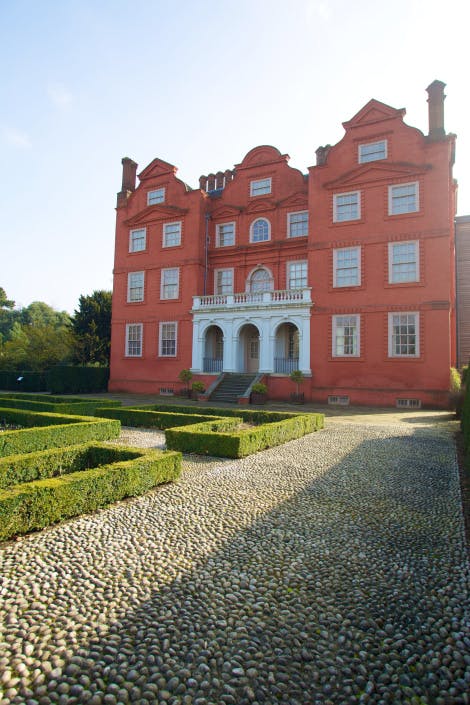
The story of Kew Palace
Britain's smallest royal palace and George III's private retreat

George III
Dutiful, intelligent and cultured, but cruelly labelled ‘mad’

The royal kitchens at Kew
The kitchens have survived, practically untouched
Explore what's on

- Things to see
The Royal Kitchens
Get an insight into life 'below stairs' at Kew Palace in the Royal Kitchens, preserved as they were in 1818 during the reign of George III.
-
Closed
- Kew Palace
- Included in Kew Gardens admission

- Things to see
- Tours and talks
The Great Pagoda
See The Great Pagoda at Kew Palace, now returned to its 18th-century splendour.
-
Closed
- Kew Palace
- Separate ticket

- Things to see
Queen Charlotte's Boudoir
A private sitting room where the Queen and her daughters passed hours waiting for news from doctors about the King's treatment.
-
Closed for winter
- Kew Palace
- Included in Kew Gardens admission
Shop online

Shop Kew Palace
Explore our exquisite collection of luxury gifts, souvenirs and homewares inspired by Kew Palace and its rich history.
From £4.50
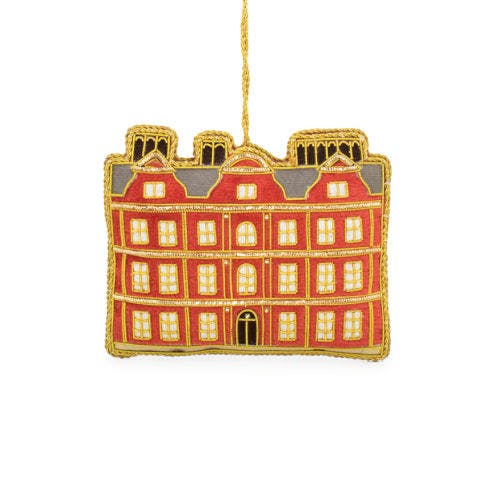
Kew Palace Decoration
This luxury handmade decoration features the exquisite Kew Palace, former royal residence located in London's Kew Gardens.
£29.99


